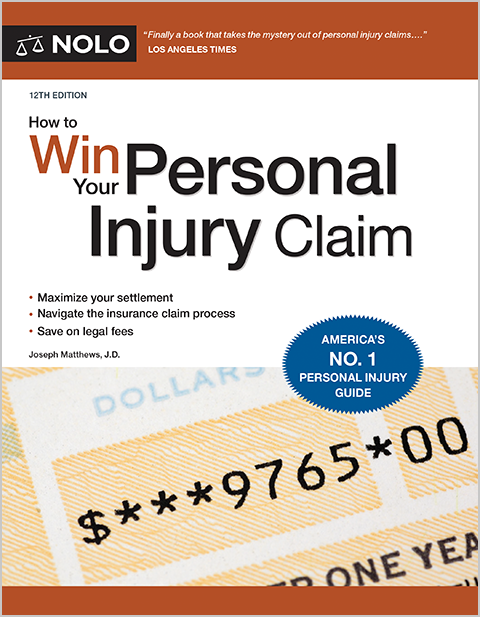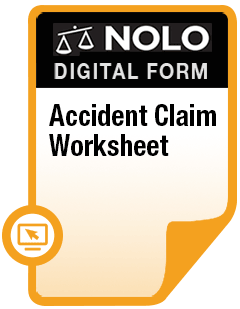Learn the rules for personal injury cases against the state of California and its local governments, including when you can sue, how to file a claim, and more.

If you're injured as a result of someone else's negligence in California, you usually have the option of filing a personal injury lawsuit against them. But what if a government entity or one of its employees caused your injury? For example, what happens if a city bus hit your car, or you tripped and fell on a broken staircase at the DMV?
In this article we'll explain the unique set of rules you'll need to play by if you've been harmed by the government or a government employee. For example, California law limits the government's liability, which means it's important to make sure you have a valid claim. And, if you do have a valid claim against a government agency or employee, you'll have to go through a special bureaucratic process before you can file a lawsuit in court. California law also sets deadlines for filing a claim, tells you where a claim must be filed, and more. It's vital to follow these rules if you want to seek compensation for your injuries.
- California Has Special Rules for Suing the Government
- When Can You Sue the Government for a Personal Injury?
- How to File a Tort Claim Against the California Government
- Time Limits for Filing Claims and Lawsuits Against the Government
- Suing the Government for a Personal Injury
- Get Help With Your California Government Injury Claim
California Has Special Rules for Suing the Government
California, like every other state, uses a rule called "sovereign immunity." Sovereign immunity is a legal concept that basically means you can't sue the government unless the government gives you permission. The California Tort Claims Act (CTCA) asserts sovereign immunity for government agencies and employees. It states that, as a general rule, "a public entity is not liable for an injury."
Like other states, California recognizes that it would be unfair to completely bar personal injury lawsuits against the state and local governments. So, the CTCA carves out exceptions that allow an injured person to seek compensation in certain situations.
We'll talk below about the procedures the CTCA requires you to follow to seek compensation for injuries caused by the government.
(Cal. Gov. Code § 815 (2024).)
When Can You Sue the Government for a Personal Injury?
The California Tort Claims Act covers the government's civil liability for personal injuries. A "personal injury," in legal terms, includes both physical harm and property damage. So, under the CTCA you might be entitled to compensation for injuries or property damage caused by government negligence. This negligence could include, for example:
- a car accident
- a slip and fall incident, or
- medical malpractice.
The CTCA also covers harms that weren't the result of negligence. This includes claims for:
- intentional torts like assault
- nuisance, and
- breach of contract.
As we'll discuss in more detail below, before filing a lawsuit in court you must first file a claim directly with the agency that harmed you.
(Cal. Gov. Code § 810.8 (2024).)
What If You Were Harmed but Don't Have a Tort Claim?
A good rule of thumb is that the CTCA applies to actions that might get a private party sued if they did the same thing. It doesn't apply to every kind of harm the government can cause. For example, you might have lost money or been inconvenienced because the a government made a mistake or acted unfairly in carrying out its normal operations. This could be the result of:
- an incorrect tax assessment
- the rejection of a permit or license application, or
- a traffic ticket you don't think was justified.
If that's the kind of case you're interested in bringing, you'll need to follow a different set of procedures. For example, the state of California has a FAQ page for what to do if you want to challenge your property tax assessment.
If you have this kind of case, or aren't sure what kind of claim to bring, an attorney may be able to help you decide what to do. In many situations a tort claim isn't going to be the best option. For example, if you think an agency made an incorrect decision, you may be able to go through an appeals process with the agency and get them to change their mind.
(Cal. Gov. Code §§ 815-818.9 (2024).)
When Is the Government Responsible for Harm Caused by Its Employees?
As a rule, a government agency or entity is not responsible for harm caused by an employee unless the employee was on the job at the time. A government employee who wasn't on the clock can only be sued in their "personal capacity." This means that any compensation would come directly from that person (or from their personal insurance). (Cal. Gov. Code § 815.2 (2024).)
We've already discussed the limits the CTCA places on lawsuits directly against the government. California law gives government employees similar protections against being sued. So, in general, the CTCA allows claims against government employees for the same sorts of acts that would allow you to sue a private individual. This includes claims for things like car accidents and negligent medical care.
But government employees have strong protections against being sued for judgment calls they must make as part of their jobs. These protections apply, for example, to:
- an agency employee deciding to deny a permit application
- a prosecutor deciding to charge someone with a crime, or
- a police officer deciding they don't have time to stop and help a motorist whose car has broken down.
On the other side of the coin, government employees are protected when they perform legally mandated duties. For example, if an application for a license or permit does not include all of the legally required information, a government employee can't be sued for rejecting it.
Finally, keep in mind that government employees aren't automatically liable if they rely on a law that is later ruled invalid or unconstitutional. A victim would still have to prove that the employee was acting maliciously, or in bad faith.
These protections make it difficult to sue government employees, but not impossible. In the worst cases--for example, when government employees act maliciously or commit a crimes--a court might decide that they aren't covered by the usual immunities that protect people as they perform government jobs. If you think you've been harmed by behavior like this, an attorney who handles lawsuits against government agencies and employees may be able to help you decide how to proceed.
(Cal. Gov. Code §§ 820-23 (2024).)
What Happens If You're Hurt by a Government Contractor?
The government, just like many private employers, often hires contractors to do certain jobs. Employers generally aren't responsible for the actions of these contractors. But employers can't just avoid liability completely by calling everyone who works for them an independent contractor. California has rules for deciding when contractors should be treated the same as employees. These rules apply to the government the same way they apply to other employers in the state.
Keep in mind that, even if you can't file a claim with the government, you may still be able to file a personal injury case seeking compensation directly from the contractor.
(Cal. Gov. Code § 815.4 (2024).)
How to File a Tort Claim Against the California Government
As we mentioned above, California has special procedures for tort claims against the government. The most important thing to keep in mind is that you can't go straight to court if you're seeking compensation from the state of California, a local government, or a government agency. Instead, you must first complete a bureaucratic process where you seek compensation directly from the government entity that harmed you. You begin this process by filing a claim.
Where Do You File a Tort Claim?
Where you file your claim will depend on which government or government agency harmed you.
Claims against local governments. If your claim is against a city or county, you'll file your claim at the local level--not with the state of California. Make sure you know and follow the local rules for submitting a claim. For example, depending on how you were harmed, you might need to file your claim either:
- with the city or county clerk's office, or
- directly with the agency that caused your injuries.
Many municipalities have online instructions for filing a claim. You may also want (or be required) to use online claim portals or forms. For example, here are resources for filing claims with:
- Fresno County
- the City of Los Angeles
- the City of Sacramento
- the City of San Diego
- the City and County of San Francisco, and
- the City of San Jose.
Claims against the state government and state agencies. If the state government or one of its employees caused your injury, you'll probably need to file your claim with California Department of General Services' Office of Risk and Insurance Management. But make sure you check the rules for the specific claim you want to file. For example:
- If you're seeking $12,500 or less from the state Department of Transportation (Caltrans), you may file your claim directly with Caltrans.
- If your claim is against one of California's public colleges or universities (or one of their medical centers), it is not covered by the CTCA. Instead, you must follow the rules laid out by the California State University system or the University of California system.
- Some state agencies--including the Department of Motor Vehicles and the Highway Patrol--use a $1,000 cut-off for handling their own claims. So, if you're seeking less than $1,000 in compensation you file a claim directly with the agency. But, if you're seeking more than $1,000, you file with the Office of Risk and Insurance Management.
If you have questions about where to file your claim, make sure to get clarification from the agency, or speak with an attorney who can help you with the process. If you file your claim with the wrong government agency or entity, you risk losing your right to compensation.
What Must Be Included in a Government Tort Claim?
The CTCA requires you to include certain information when you submit a claim. As we mentioned above, government agencies and other public entities in California often have a form they want (or require) you to use. Using this form is the best way to make sure you don't forget to include any required information. In general, your claim must list:
- your name and contact information
- the address where you want to receive notices about your claim (for example, your attorney's office)
- details about the incident, including where and how it happened
- a general description of your injuries or financial losses
- the names of the employees who harmed you (if you know them)
- information about how much compensation your seeking.
(Cal. Gov. Code § 910 (2024).)
What Happens After You File Your Claim?
Once you file a claim, the government has 45 days to respond.
Under the CTCA, the agency (or whoever is considering your claim) is supposed to use that time to examine your evidence and either:
- Offer you a settlement. This could be the full amount you requested, but it will often be less. Remember that you can negotiate the settlement amount, just like you could if you were trying to settle a lawsuit or an insurance claim. Just keep in mind that the deadline for filing a lawsuit (which we'll discuss in the next section) is measured from the time the government makes its first settlement offer. So you'll either have to agree to a settlement or file a lawsuit within that period of time.
- Reject your claim. If the government rejects your claim, they will send you a letter explaining their reasons, and providing information about your right to file a lawsuit.
Sometimes the government might not respond at all within the required 45-day period. If the government doesn't meet this deadline, you have the right to pursue your claim by filing a lawsuit. But, if the agency just needs more time to finish its review of your claim, it might ask you to extend that 45-day deadline. You can either agree to an extension, or hold the agency to the original deadline.
(Cal. Gov. Code § 912.4 (2024); Cal. Gov. Code § 913.2 (2024).)
Time Limits for Filing Claims and Lawsuits Against the Government
Claims against the government are subject to strict deadlines:
- You must file a claim with the government agency within six months of the date of your injury. (Remember that you may have more time if your case involves something like a contract dispute, and not a personal injury claim.) If the government rejects your claim, or does not respond within the 45-day time limit, you can then file a lawsuit in court.
- If your claim is explicitly rejected, you must file any lawsuit within six months of the rejection.
- If you get no response within 45 days, you must usually file a lawsuit within two years of suffering your injury or property damage.
If you miss these deadlines, you will probably lose your right to seek compensation. You're allowed to ask for more time, but you'll have to have a very good reason (for example, you could not file a claim because you were physically or mentally incapacitated). It is always better to file a claim as soon as you can, and meet all legally imposed deadlines.
(Cal. Gov. Code § 911.2 (2024); Cal. Gov. Code § 945.6 (2024).)
Suing the Government for a Personal Injury
Once you've completed the claims process you can then file a personal injury lawsuit in court. Even though the defendant is the government (or a government employee) the process will generally be the same as any other California personal injury case.
There are important differences, though. For example, unlike in a standard personal injury lawsuit, you cannot be awarded punitive damages in a tort lawsuit against the government. And remember that the government and its employees will often have strong arguments for why they can't be held liable for your injuries. They can make these arguments in a lawsuit just like they can during the claims process.
(Cal. Gov. Code § 818 (2024).)
Get Help With Your California Government Injury Claim
Any personal injury case can be complicated. But, as we've seen, seeking compensation from a government agency or employee can be particularly challenging. The law and rules aren't always easy to understand, and the government often has strong arguments it will make against your claim. So, if you think you may have a claim against the government in California, you'll probably want to speak with an attorney. An attorney with experience handling these kinds of cases will be able to help you understand your options and, if necessary, assist you with the claims process and a potential lawsuit.
- California Has Special Rules for Suing the Government
- When Can You Sue the Government for a Personal Injury?
- How to File a Tort Claim Against the California Government
- Time Limits for Filing Claims and Lawsuits Against the Government
- Suing the Government for a Personal Injury
- Get Help With Your California Government Injury Claim


